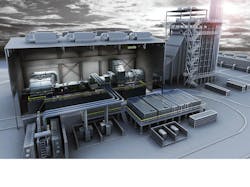General Electric’s nuclear-power business, GE Hitachi Nuclear Energy (GEH) has outlined a series of steps that will further detail its collaboration with Advanced Reactor Concepts LLC, a partnership announced earlier this year to develop and license the ARC-100 advanced small modular reactor (aSMR).
“This new agreement recognizes that GEH and ARC Nuclear each have significant experience, investment, and intellectual property in sodium fast-reactor technology,” stated Jon Ball, executive vice president, Nuclear Plant Projects, GEH.
Small modular reactors are a type of nuclear fission reactor that are smaller than conventional reactors, and manufactured at one site and then relocated to a final location for assembly.
In March, GEH and ARC agreed to consolidate their efforts at commercializing a small, modular nuclear reactor, specifically to install the ARC-100 aSMR, initially in Canada. Until that time both companies had developed reactor designs based on the EBR-II, an integral sodium-cooled fast reactor prototype, which was developed by Argonne National Laboratory and operated successfully for more than 30 years at Idaho Falls, Idaho.
But, GEH’s PRISM reactor and ARC Nuclear’s ARC-100 have had different objectives. The ARC-100 is a 100 MWe aSMR, designed for efficient and flexible electricity generation, while operating for up to 20 years with no need for refueling.
The ARC PRISM reactor is designed to be refueled every 12 to 24 months; it’s primarily focused on closing the fuel cycle by, among other things, consuming transuranics (unstable elements.)
Both aSMR designs share fundamental features, such as high-energy neutrons, liquid sodium cooling and metallic fuel, which provides inherent safety performance and economically competitive plant architecture compared to traditional water-cooled reactors.
Within their new development agreement, GEH intends to license intellectual property associated with its PRISM advanced reactor design to ARC Nuclear. GEH also intends to give ARC access to its nuclear infrastructure quality, safety, and training programs, along with other related processes, procedures, and tools.
Also, GEH will provide relevant engineering and design services to ARC Nuclear.
“Our work to date with the GEH team has validated our expectation of the synergy of combining ARC Nuclear’s senior engineers — with their deep sodium fast reactor operational and design experience as key members of EBR-II prototype program — with GEH’s next generation of nuclear engineers and designers with their proven competence in modern nuclear design,” stated Don Wolf, chairman and CEO of ARC Nuclear.
GEH and ARC also continue to work toward a preliminary regulatory review of the ARC-100 by the Canadian Nuclear Safety Commission. At the same time, the have a joint engineering team working to advance the ARC-100 design.
About the Author
Robert Brooks
Editor/Content Director - Endeavor Business Media
Robert Brooks has been a business-to-business reporter, writer, editor, and columnist for more than 20 years, specializing in the primary metal and basic manufacturing industries. His work has covered a wide range of topics including process technology, resource development, material selection, product design, workforce development, and industrial market strategies, among others.
Currently, he specializes in subjects related to metal component and product design, development, and manufacturing—including castings, forgings, machined parts, and fabrications.
Brooks is a graduate of Kenyon College (B.A. English, Political Science) and Emory University (M.A. English.)

